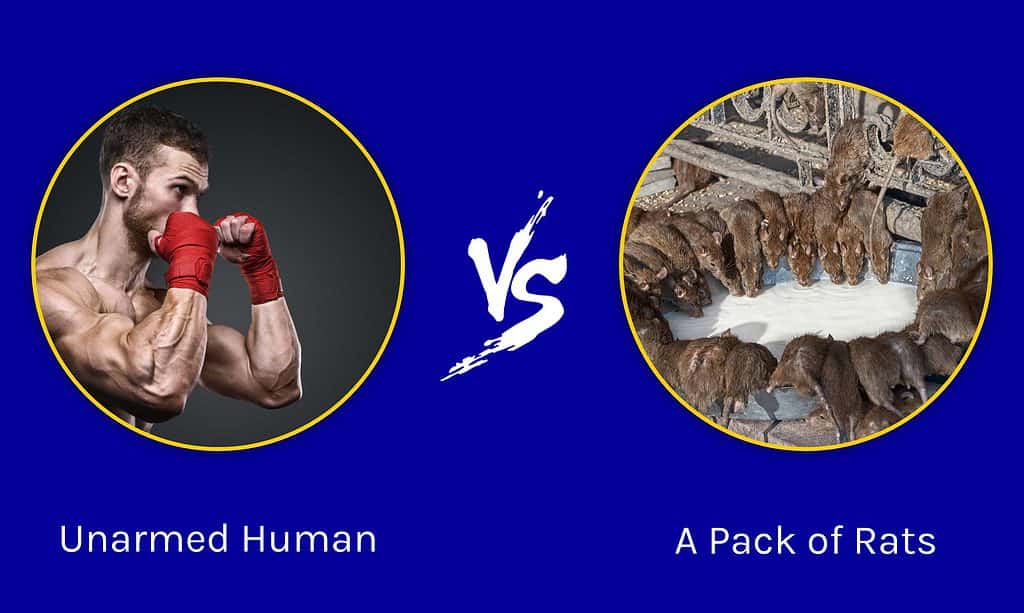Rats have followed humans around the world. You can find these mammals just about anywhere that you can find humans. They love digging through our trash and pantries in hopes of stealing a tasty morsel. While we tend to use a broom to shoo them away or traps to kill them, a human can easily overcome a single rat. Yet, what if a person went into a storeroom and found themselves without a weapon and faced a bunch of rats? Would an unarmed human beat a pack of rats in a fight, or would the person perish?
That’s the question we’re here to answer. We will examine this fight from many angles and give you a realistic answer as to what you can expect from a fight against these critters.
Comparing an Unarmed Human and a Pack of Rats

| Unarmed Human | Pack of Rats | |
|---|---|---|
| Size | Weight: usually between 130 pounds and 199 pounds Height: between 5 feet 3 inches and 5 feet 9 inches on average, but higher heights are relatively common | Weight: 0.3 to 1.1 pounds Length: 6 to 11 inches in body length, up to 20 inches long total with tail |
| Speed | – Often walk at speeds of 2 to 3 mph – Usually run between 6.5 and 8 mph | – Up to 8 mph |
| Defenses | – Has intelligence that allows them to change the situation in their favor – Can use the environment against other animals – Has high stamina – Can overcome their innate fear to do what’s necessary to survive – Has many physical weak spots like the eyes, throat, and neck | – It’s a fast and agile creature that can dodge most attacks – Can hide in small spots to dodge attacks – Has good senses of smell, hearing, and touch to get away from predators – A pack of rats has the numbers to make it hard to kill a specific individual – Individually, rats have few defenses against larger animals |
| Offensive Capabilities | – Can kick, stomp, punch, and grapple other animals – Has a weak bite force of less than 200 PSI, along with small teeth – Human teeth could be used to harm small animals in a dire situation – May use intellect to identify weak spots of prey and attack those areas | – Moderate bite force that allows them to bite through the flesh of other mammals – Rats can gnaw through hard materials – Teeth measure between 0.2 inches and 0.3 inches, but they’re constantly growing and ready to bite |
| Predatory Behavior | – Without tools or weapons, humans often rely on ambushes – In the case of a pack fight, the human will simply have to enter the foray and fight the other creatures | – Opportunistic predator that finds food where it can – Prefers to scavenge and forage but also kills smaller critters and insects, including other rats – They are not group hunters that bring down large prey |
What Are the Key Factors in a Fight Between an Unarmed Human and a Pack of Rats?
As with most fights, the biggest factors in a fight between an unarmed person and a pack of rats include defenses, offenses, and size. We’ll also discuss other dimensions of this battle as well, but they won’t play a large role.
The best way to determine the winner of this battle is to compare and contrast the major factors, see which animal has the most going for them, and then use a bit of educated guesswork to figure out how this battle would go down in the wild. Let’s start by looking at the differences in size.
Unarmed Human vs. Pack of Rats: Size

Humans are larger than rats.
©Robert Kneschke/Shutterstock.com
Humans are much bigger than rats. The brown rat, the creature we’re using for this fight, often weighs less than 1 pound. They average between 0.3 and 1.1 pounds in total mass while growing up to 11 inches in body length and 20 inches in total length.
Humans are much larger. They weigh up to 200 pounds or more, and they average between 5 feet 3 inches and 5 feet 9 inches in height. Yet, they can get much larger in both measures.
Any way we look at it, the human has the size advantage in this battle.
Unarmed Human vs. Pack of Rats: Speed

Rats can run as fast as 8 mph.
©Heiko Kiera/Shutterstock.com
The average person runs at speeds of between 6 and 8 mph. Although humans are far from clumsy, they aren’t as agile as smaller creatures with better fast-twitch muscles. The average rat can move at speeds up to 8 mph, but they may not have as much stamina to travel great distances as humans.
Still, faster humans can outpace rats. Some people can reach over 20 mph while running, but those are few. For the sake of this fight, the average rat and human can move at roughly the same maximum speeds.
Unarmed Human vs. Pack of Rats: Defenses
The pack of rats will find strength in numbers. That will make it hard for the human to focus on just one of them during this bout. Rats are agile, and they can hide in impossibly small places. However, there will be no hiding in this fight. Without the ability to escape, rats have rather poor defensive powers. Their bodies are small and weak compared to a human.
Humans are somewhat unique in that they can use their intelligence to gain an advantage in this battle. They can calm themselves to face the task at hand and survive against what looks to be overwhelming odds, going against their instincts to live.
Aside from our mental capacity, humans have a high level of stamina to help them last longer in a fight. While humans have weak spots all over their bodies for rats to exploit, they also have the size needed to frighten smaller animals into complacency.
Humans have a defensive advantage in this bout.
Unarmed Human vs. Pack of Rats: Offensive Capabilities
In a fight against a pack of rats, humans have an offensive advantage. Simply put, they’re so large and strong. Humans can grab, punch, kick, stomp, bite, and throttle other creatures, even small ones. More importantly, they can use their minds to focus on the task at hand, survival, rather than the gruesome reality they’re about to endure.
Rats have teeth that keep growing throughout their lives, and they can use them to great effect. They can bite through a variety of substances given enough time. While they won’t be able to bite off great chunks of flesh from a moving person, the chances are that they will still have the opportunity to deliver several bites throughout this battle.
Still, humans continue to have the offensive advantage.
Unarmed Human vs. Pack of Rats: Predatory Behavior
Rats are not apex predators, but they feed on other creatures when the opportunity arises. Some cases exist where rats will turn on each other to feed. Still, their prey drive isn’t as strong as true hunters.
Meanwhile, humans prefer to raise their food rather than hunt it in most cases. Without access to tools or weapons, humans have to take a direct approach or an ambush approach to battle.
Parameters of an Unarmed Human vs. Pack of Rats Fight
Before we get to the fight, we have to set the guidelines. First off, we are using the average measurements of the Rattus norvegicus, the species of rat that plagues major cities in the U.S.
Next, we are going to pit the human against 20 rats. The average nest contains 10 or so rats, but 20 rats seem like a fairer fight.
Lastly, the fight will take place in an enclosed room with the lights on and no way for the rats or the human to escape. Now that we’ve established some guidelines for the battle, let’s figure this out.
Who Would Win in a Fight Between an Unarmed Human and a Pack of Rats?

The fight between a pack of rats and an unarmed human would be won by the latter.
©restyler/Shutterstock.com
An unarmed human could beat a pack of rats in a fight. Still, the outcome of this fight is somewhat dependent on two things. First, if the person cowers at the sight of the rats and won’t fight, they will lose. In a survival situation, people often rise to the occasion, so it seems like the human will fight back.
Secondly, the rats will need to overcome their instincts to run away from the larger animal. That is something hardwired into them. Even if they are hungry and they can override their initial fears, the thrashing, screaming human will make them second-guess their position.
If the rats are hungry or somehow realize that they are being hunted down and killed by the human, they could fight back and deliver a lot of painful bites to a person. Yet, every time they pause and bite, the person can grab one and take it out of the fight. The rats can probably skitter faster than the human can catch them.
Yet, when it comes down to a battle, the winner is not always the last one standing. Sometimes, the winner is the individual that doesn’t lose the will to fight. After the rats realize they are facing something much taller and stronger, they’ll run.
A kick, a stomp, a bite— humans are loaded with ways to remove mice from the battleground effectively. As grisly as it may seem, the person has a good chance of getting out of this fight because rats are not predators that know how and where to strike a person to finish them.
The only way the rats would win is if they coordinated to run from the person until the human gave up or was so worn out that they couldn’t fight back.
Up Next:
- Could an Unarmed Human Beat a King Cobra?
- Could an Unarmed Human Beat a Gorilla?
- Could an Unarmed Human Beat a Crocodile?
- Could an Unarmed Human Beat a Wolf?
The photo featured at the top of this post is © restyler/Shutterstock.com
Thank you for reading! Have some feedback for us? Contact the AZ Animals editorial team.






